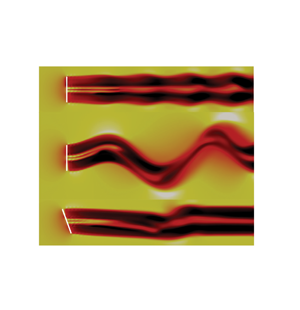Article contents
Mechanisms of dynamic near-wake modulation of a utility-scale wind turbine
Published online by Cambridge University Press: 13 September 2021
Abstract

The current study uses large eddy simulations to investigate the transient response of a utility-scale wind turbine wake to dynamic changes in atmospheric and operational conditions, as observed in previous field-scale measurements. Most wind turbine wake investigations assume quasi-steady conditions, but real wind turbines operate in a highly stochastic atmosphere, and their operation (e.g. blade pitch, yaw angle) changes constantly in response. Furthermore, dynamic control strategies have been recently proposed to optimize wind farm power generation and longevity. Therefore, improved understanding of dynamic wake behaviours is essential. First, changes in blade pitch are investigated and the wake expansion response is found to display hysteresis as a result of flow inertia. The time scales of the wake response to different pitch rates are quantified. Next, changes in wind direction with different time scales are explored. Under short time scales, the wake deflection is in the opposite direction of that observed under quasi-steady conditions. Finally, yaw changes are implemented at different rates, and the maximum inverse wake deflection and time scale are quantified, showing a clear dependence on yaw rate. To gain further physical understanding of the mechanism behind the inverse wake deflection, the streamwise vorticity in different parts of the wake is quantified. The results of this study provide guidance for the design of advanced wake flow control algorithms. The lag in wake response observed for both blade pitch and yaw changes shows that proposed dynamic control strategies must implement turbine operational changes with a time scale of the order of the rotor time scale or slower.
- Type
- JFM Papers
- Information
- Copyright
- © The Author(s), 2021. Published by Cambridge University Press
References
REFERENCES
Abraham et al. supplementary movie 1
- 5
- Cited by



